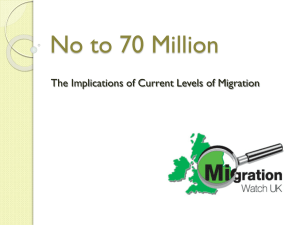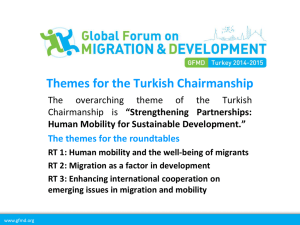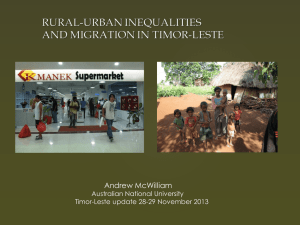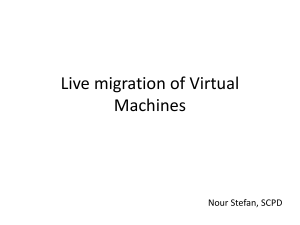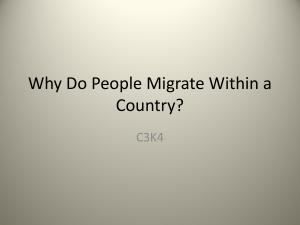International dialogues on migration and development
advertisement
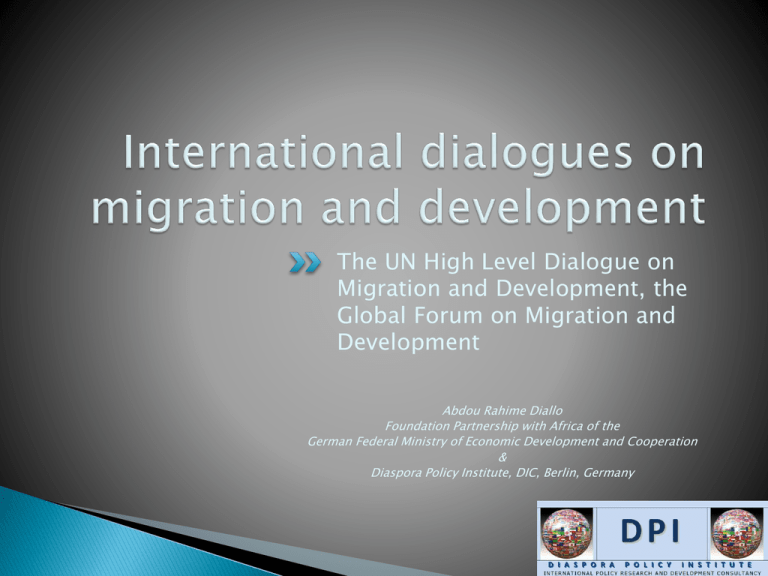
The UN High Level Dialogue on Migration and Development, the Global Forum on Migration and Development Abdou Rahime Diallo Foundation Partnership with Africa of the German Federal Ministry of Economic Development and Cooperation & Diaspora Policy Institute, DIC, Berlin, Germany Changing thoughts on Migration and Development Period Until 1973 Research community Development and migration optimism Policy field Develop-mentalist optimism; capital and knowledge transfers by migrants would help development countries in development take-off 1973-1990 Development and migration pessimism Growing scepticism: concerns with brain drain; after (brain drain and dependency) experiments with migration return policies focused on integration in receiving countries. Migration largely out of sight in development field. 1990-2001 Readjustment to more subtle views under Persistent scepticism: tightening of immigration policies. influence of increasing empirical work (New Economics of Labour and Migration (NELM), livelihood approaches, transnationalism) >2001 Boom in publications: mixed, but generally Resurgence of migration and development optimism under positive views influence of the outcome of the research on remittances boom and a sudden turnaround of views: brain gain, diaspora as a driver of development. Background and Objectives Operating modalities GFMD – BACKGROUND recent UN initiative to address the M&D-nexus in practical and action orientated ways as a culmination of more than a decade of international debate on the growing importance of the M&D nexus 3 Formative initiatives pre-dating the GFMD Commission on THE UN POPULATION & Global DEVELOPMENT CONFERENCE, International Migration (CGIM) by, Mr. Kofi Annan, in 2003 CAIRO, 1994. Endorsement of a Program of Action, including a chapter on international migration (Chapter X) ranging across remittances, temporary migration, transfer of knowledge, skills and technology etc. and calls for "orderly international migration that can have positive impacts on both the communities of origin and the communities of destination". THE UN GENERAL ASSEMBLY 2006, HIGH LEVEL DIALOG ON INTERNATIONAL MIGRATION & DEVELOPMENT Presenting its report and recommendations to UN Members the UN Secretary-General and his States and the international Special Representative on community in 2005: International Migration and 6 Principles for Action covering all aspects of human mobility and migration governance, including the interconnections between migration and development. Development proposed the creation of the GFMD. This proposal was endorsed by a large majority of the General Assembly, as was the Belgian offer to launch the GFMD process. The first meeting took place in Brussels in July 2007 in the presence of the Secretary-General of the UN. 1. •To provide a venue for policy-makers and high-level policy practitioners to informally discuss relevant policies and practical challenges and opportunities of the migration-development nexus, and engage with other stakeholders, including nongovernmental organizations, experts and migrant organizations to foster practical and action-oriented outcomes at national, bilateral and international level 2. •To exchange good practices and experiences, which can be duplicated or adapted in other circumstances, in order to maximize the development benefits of migration and migration flows; 3. •To identify information, policy and institutional gaps necessary to foster synergies and greater policy coherence at national, regional and international levels between the migration and development policy areas; 4. •To establish partnerships and cooperation between countries, and between countries and other stakeholders, such as international organizations, diaspora, migrants, academia etc., on migration and development; 5. •To structure the international priorities and agenda on migration and development With the exception of some guidelines (for example on the state-led character) the operating modalities for the GFMD process were not formalized by the UN General Assembly Endorsement of GFMD operating Modalities at the 1st meeting, Brussels 2007 ◦ Ensuring continuity and practical support for the incoming Chairs of the Forum ◦ Providing an initial structuring framework to 'organize' GFMD chairing arrangements and funding and support to the Chair ◦ Provision for the creation of a supporting framework: Troika: the past, current and future GFMD Chairs Steering group: manageable number of governments that lend strategic and political support to the Chair Consultative body: Friends of the Forum (States Members and Observers of the United Nations) Light support unit: assist the Chair-in-Office with its administrative, financial and logistical needs Objectives Strategic thematic fields Recommendations Objective 1 Obejctive 2 Objective 3 •Creating a better understanding of migration and development •Identifying stress fields •Track recording the development of international M&D debates •Generating more impact on decision making processes in the field of M&D •Creating a platform for new M&D debates (inviting experts from “new” regions to receive new insights) •Consolidating the increasing number of regional initiatives focusing on the migration and development nexus and strategies on the national and supranational level •Creating a better orientation for interdisciplinary scientific and applied research and cooperation •Highlighting the M&D as a policy area and a paradigm •Laying the ground for new academic cooperation and high-level exchange and discussions •Laying the ground for enhanced knowledge about M&D •Laying the ground for a better policy and decision making (1)The high level dialogue on migration and development (HLD) The subject of migration and development focuses on the connections and intersections between migration and development, and has evolved as a policy area, an area of study, and (more controversially) has been posited as a development paradigm. Nevertheless, migration and development has become increasingly central both to academic discourse and policy discussions. Acknowledging migration and highlighting the migration and development nexus: At the EU level, the 2005 Global Approach to Migration (GAM) sought to embed these issues into an overarching framework for the EU policy on external migration, aligning policies on development, foreign policy, immigration, and labour markets. The GAM was re-launched in 2011 as the Global Approach to Migration and Mobility, and includes both a migrant-centred approach and issues such as South-South migration (2)The high level dialogue on migration and development (HLD) Similarly, the Euro-African Conference on Migration and Development in 2006 (the ‘Rabat process’) focused on migration and development issues related to the “WestAfrican migration route” including migration to Europe from northern, central and western Africa, and there are several programmes established within regional groupings such as ECOWAS, the East African Community (EAC), and the Economic Community of Central African States (ECCAS). Migration and development also featured in the Cotonou Agreement (2000) between the EC and the African, Caribbean, and Pacific (ACP) regions, which promoted economic integration of these as well as sustainable partnerships for development. Other examples include the South American Conference on Migration, or the Ministerial Consultations on Overseas Employment and Contractual Labour for Countries of Origin and Destination in Asia (the ‘Abu Dhabi Dialogue’). (3)The high level dialogue on migration and development (HLD) The Indian and Chinese diaspora (in Singapore, Taiwan, and Hong Kong as well as the West) played a role in critical points of the economic take-off of both countries (as well as countries of residence) in the late 1970s, 80s and 90s, providing massive investment, knowledge, skills and other know-how.16 These diasporas were harnessed to support a strong structural transformation agenda. A key part of that agenda was also the up skilling and integration of women, especially in China, into the development agenda. This latter case also shows the pivotal role that can be played by female migrants, which is of increasing relevance given the growing feminisation of migration. Diaspora capital in these two cases has been a factor – among several – in enabling the economies of China and India to grow over the last thirty years, a phenomenon which has arguably lifted more people out of poverty than the MDGs. The bulk of the research and other literature on diaspora and migrant financial capital have focused on remittances, and the levels of resource involved are impressive: $50 bn was formally remitted to Africa alone in 2012 from the African diaspora worldwide. Countries of origin are increasingly alert to the potential offered by diaspora financial capital, and have set in place a number of schemes to encourage diaspora investment. Some examples focus on labour and tax incentives for the diaspora, such as India’s Non-Resident Indian (NRI) and Person of Indian Origin (PIO) schemes; others include the diaspora bond schemes developed by governments in Ethiopia, Kenya, and Rwanda, or sovereign wealth funds such as Rwanda’s ‘Agaciro’ fund, which aims to attract diaspora investment. (4)The high level dialogue on migration and development (HLD) Starting with the 1994 Cairo Conference on Population and Development, which stressed the need to maximise the benefits of migration, and ‘increase the likelihood that migration has positive consequences for development”, there have been a number of international policy fora focusing on the link between migration and development: the 2001 Swiss-led Berne agreement; the 2003 ‘Doyle Report’, which proposed an independent commission on governance of migration; the first UN High Level Dialogue on International Migration and Development in 2006; and the Global Forum on Migration and Development (GFMD) which emerged from this. 2013 a useful and authoritative overview of the migration and development policy initiatives has been produced but it is worth noting the point that “dialogue and cooperation on migration initially developed at the regional or inter-regional level in the framework of a series of state-led, non binding, regional migration dialogues or consultative processes”, largely because of political considerations in destination countries. There have also been a number of regional initiatives focusing on the migration and development nexus. At the EU level, the 2005 Global Approach to Migration (GAM) sought to embed these issues into an overarching framework for the EU policy on external migration, aligning policies on development, foreign policy, immigration, and labour markets. The GAM was (5) The high level dialogue on migration and development (HLD) Portraying the diaspora as key stakeholder of : Remittances knowledge transfer and brain gain Circular migration Reflecting on challenges and obstacles to develop and implement migration and development policies Lack of awareness that migration is development strategy rather than a threat a Economic development through job creation Lack of policy coherence to develop and and remittances implement policies with all stakeholders Diaspora capital on Co-development practice Lack of integration into the policy framework Strategic position and role as diaspora as More supra-national bridge builder and driver of change cooperation is needed and international More cooperation with grassroots organisation is needed • Evolution of Migration and development as a Policy Area and Paradigm • Progress on Migration and Development Policy Development and Implementation 1. • Integration of M&D Nexus, M&D into national, regional and supra-national development strategies and policies • The Role of Migration and Diaspora in the M&D & MDGs to Date • Diaspora and Development as a Paradigm 2. • Diaspora as Key stakeholders in Migration & Development: Financial, Intellectual, Social and other Capital of the Diaspora • Diaspora participation in M&D policy processes • Civil Society Involvement in HLD 2013 3. • HLD and the Post-2015 Development Framework • Integration of M&D Nexus, M&D into the Post-2015 agenda




